The HTC One X for AT&T Review
by Brian Klug on May 1, 2012 6:00 PM EST- Posted in
- Smartphones
- Snapdragon
- HTC
- Qualcomm
- MSM8960
- Krait
- Mobile
- Tegra 3
- HTC One
- NVIDIA
The One X has a 4.7“ 1280x720 display that’s beautiful, dubbed the ”infinity screen.“ In fact, that’s really all you need to know about it - it’s absolutely wonderful, and honestly if you’re concerned with mobile displays just stop right there. At above 4.5” diagonal, 720p seems to be the new norm, and the combination of that 4.7" diagonal size and 720p on the HTC One X results in a PPI of 312. HTC shipped a device with an LCD display last year whose pixel density exceeded the iPhone 4/4S Retina Display for the first time in the HTC Rezound, which was 341 PPI.
Nevertheless the HTC One X still has subpixels small enough that I can’t visually distinguish them at all but from the most extreme distances. In addition, because it’s LCD you get an RGB stripe as opposed to PenTile RGBG like what currently ships on Samsung’s SAMOLED HD displays at 720p in the Galaxy Nexus.
I did some poking around, and my HTC One X (AT&T) review unit has a Sony display:
[DISP] mipi_video_sony_hd720p_init: assign initial setting for SONY_NT id 0x18103 Cut1, PANEL type = PANEL_ID_ELITE_SONY_NT
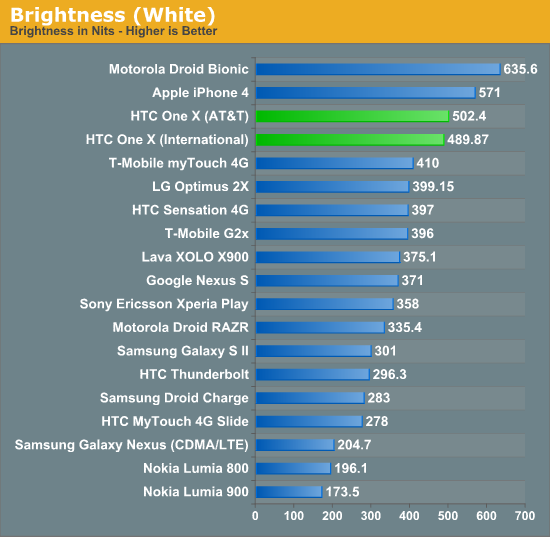
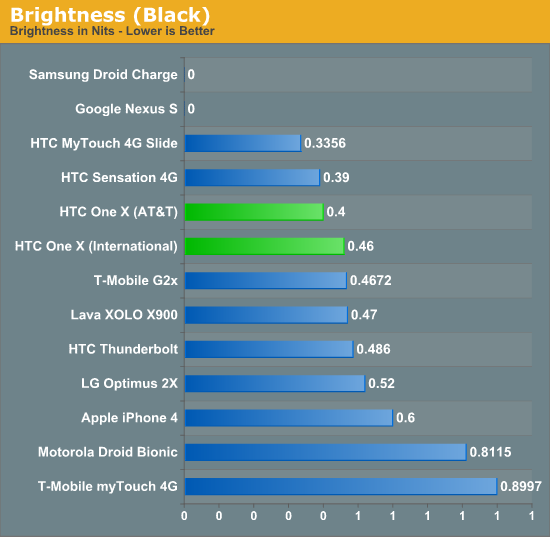
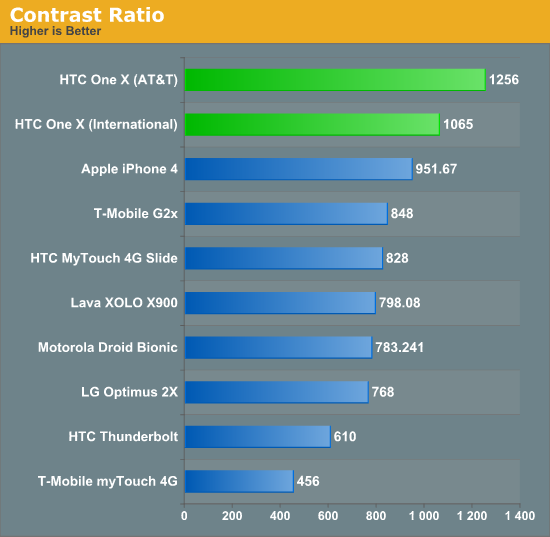
The panel goes extremely bright, at over 500 nits maximum, and has top of the chart contrast. As always I characterized the One X display using a combination of ColorHCFR and an i1D2 and Francois’ excellent Voodoo Screen Test Pattern generator application.
I’ve made both the color.chc file and measures available. The CIE diagram shows that HTC’s Infinity Display has very close to sRGB coverage, however color temperature is on the red side at just under 6000K. That’s really my only gripe, and curiously enough the One S with SAMOLED qHD displays are closer to 6500K than the LCD packing HTC One Xes.
Viewing angles look good on the HTC One X, there's no visible color shift at extreme angles. Outdoor viewing is also pretty good on the HTC One X, thanks in part to optical bonding between the display glass and LCD itself. One fewer air gap means fewer Fresnel reflections which quickly turn a display into a mess outdoors.


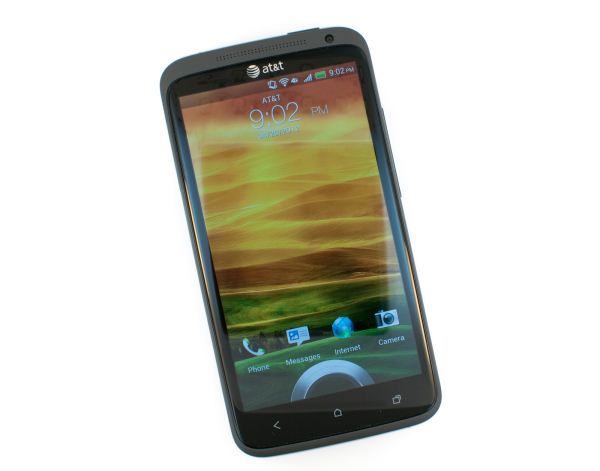












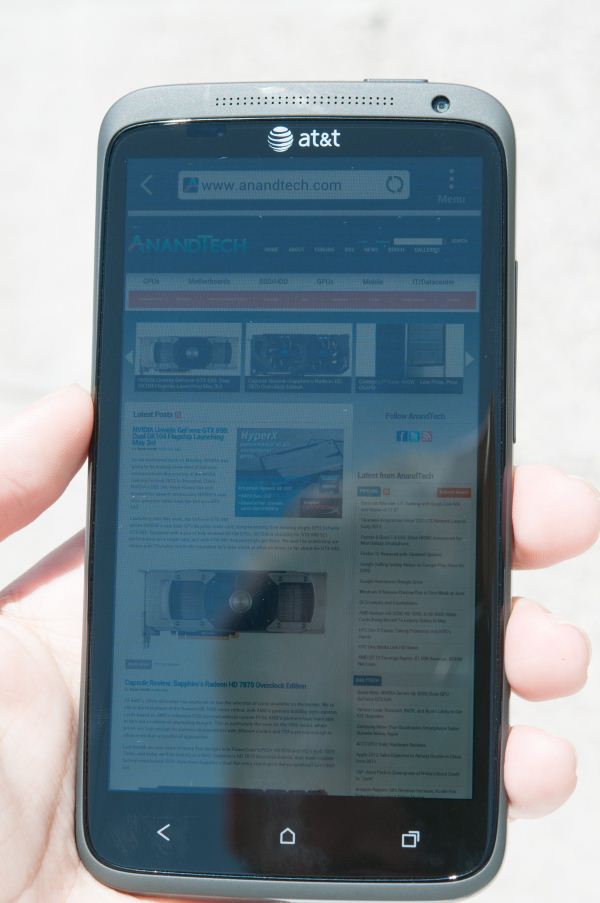








137 Comments
View All Comments
frostyfiredude - Tuesday, May 1, 2012 - link
If there is one difference that really stood out between the International and ATT versions of the One X, it's the battery life. For all the talking nVidia did about Tegra3 allowing world beating battery life, it really got served by the S4 in that regard.In the fall I really hope HTC makes a One X like phone with WP8 on it, if I'm not feeling cheap I think I'll buy one.
ImSpartacus - Tuesday, May 1, 2012 - link
Yeah, that's really the most important thing for me. I'm glad Anandtech puts it earlier in the reviews.Chloiber - Wednesday, May 2, 2012 - link
It's true. I'm currently owning a One X (international). I'm okay with the battery life (it's better than my previously HTC Desire). But as Brian has mentioned, software updates are on the way. The second update has been released yesterday. The updates are coming out nearly weekly! The improvements are huge in many aspects. The last update (released yesterday in Europe for unbranded devices) finally enabled 2D GPU Acceleration. That's right: 2D GPU Acceleration wasn't working properly before. It couldn't even be forced in the dev settings.I really hope they can improve the device even more, and I'm pretty confident they will. To be perfectly honest, I would have preferred the S4 version of the One X. Nvidia still seems to have some problems with the T3 - again, I'm confident that the device's performance and battery life will improve massively over the next couple of months, but S4 seems to be the safer bet.
pikahatonjon - Tuesday, May 1, 2012 - link
i know its offtopic, however, how come it seems like the Droid Razr performs like 40% better than the galaxy nexus 58.7 fps vs 33.1 when they both have the same SoC? was there some error in the testfrostyfiredude - Tuesday, May 1, 2012 - link
Higher resolution display on the Nexus would be the cause of most if not all of the difference. 960x540 for the RAZR v 1280x720 for the NexusPyroHoltz - Wednesday, May 2, 2012 - link
I really wish Anandtech would normalize the graphics benchmarks to FPS/megapixel of screen resolution.Or, implement something that will take the fluctuations in native resolution, out of the equation a bit.
Goty - Wednesday, May 2, 2012 - link
Just look at the "offscreen" numbers, those are all rendered at the same resolution regardless of handset.ChronoReverse - Wednesday, May 2, 2012 - link
The Offscreen Test is a seriously flawed one. It's clear that the act of rendering to the screen has a different penalty for different GPU's.Since you have to render in actual 3D applications, this means that the Offscreen test is worse than useless since it's _misleading_.
You can't even say it's a VSync issue because in this very article, you have the GLBenchmark test at 720P where the results for both the Global and ATT OneX phones are both significantly below 59-60FPS.
Goty - Wednesday, May 2, 2012 - link
Writing of the framebuffer to the screen is the least part of what each GPU has to do and certainly has less of an impact that differing resolutions between screens; I highly doubt that writing out the framebuffer is even that different between different architectures.metafor - Thursday, May 3, 2012 - link
It's very much in line with the V-Sync results we've seen with the MDP and other devices that allow you to turn V-Sync off.The tests with the Qualcomm MDP show exactly this kind of difference with V-Sync turned on and off, even if the resulting average doesn't come close to 60fps.
Why? Because framerate can vary by a lot within the running of the benchmark. Simple sequences can burst up to the 100's of frames per second. That will throw off the average by a lot.